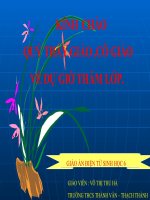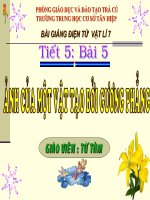- Trang chủ >>
- Đại cương >>
- Kinh tế vi mô
Unit 5 LanFocus thao giang
Bạn đang xem bản rút gọn của tài liệu. Xem và tải ngay bản đầy đủ của tài liệu tại đây (1.13 MB, 24 trang )
<span class='text_page_counter'>(1)</span>WELCOME TO OUR CLASS! UNIT 5: TECHNOLOGY AND YOU E – LANGUAGE FOCUS (1st period).
<span class='text_page_counter'>(2)</span> REVIEW transmit. Complete the sentences, using the words in the box.. receive process. store. design. hold. Information technology allows us to: 1. __________ transmit information quickly, 2. __________ very large amounts of information, store 3. __________ messages from one computer to another, send 4. __________ long distance meetings, hold 5. __________ houses, bridges, gardens and buildings, design 6. __________ TV programs from other countries, receive 7. __________ information as soon as we receive it. process. send.
<span class='text_page_counter'>(3)</span> Let’s start Unit 5. Technology and You E- Language Focus (1st period). BACK TO SCHOOL.
<span class='text_page_counter'>(4)</span> WARM UP. Short story: “The blue car”. The blue car zooms on the way. The sky and the water are blue. The weather is sunny and cool. The woman in the car plays good music. She is too busy to look at the lake. She is in a hurry to buy some foods. She wants to cook a delicious meal..
<span class='text_page_counter'>(5)</span> PRONUNCIATION (short). /Ω/. woman good look cook. /u:/ (long). blue zoom cool too foods.
<span class='text_page_counter'>(6)</span> PRONUNCIATION (short). * Listen and repeat / u: / (long). /Ω/. put. food. pull. school. full. foot look cook. tooth. fruit June afternoon.
<span class='text_page_counter'>(7)</span> PRONUNCIATION. Practise these sentences. 1. Could you tell me where you’ve put my book? 2. Your bookshelf is full of books. 3. Look! The boy is looking at your book. 4. Miss June is looking at the Moon. 5. Both your shoes and your boots are dirty. 6. Miss Moon went to school this afternoon.. 7.
<span class='text_page_counter'>(8)</span> GRAMMAR. PRESENT PERFECT TENSE (Active and Passive) Subject of the sentence (person or thing) does the action. Active voice. Engineer 1:. Which company has carried out this project? Engineer 2: “Delta” company has carried out this project. Engineer 1: When has the building been built? Engineer 2: This building has been built since June.. Subject of the sentence is a result of the action. (The person who does the action is not known or not important.). Passive voice.
<span class='text_page_counter'>(9)</span> GRAMMAR. FORM OF PRESENT PERFECT. Active form: (+) S + have/has + V3/ed + O (-) S + haven’t/hasn’t + V3/ed +O (?) have/has + S + V3/ed + O?. Passive voice: (+) S + have/has been + V3/ed + by O (-) S + haven’t/hasn’t been + V3/ed + by O (?) have/has + S + been + V3/ed + by O?. A: You know, my father wrote this book. He has written many books since he was 15. B: Really? Have you read all of his books? A: No. I haven’t read all of them yet.. A: Look! Three paintings have just been drawn by Tom. B: Have they been displayed on exhibition? A: No. They haven’t been displayed on exhibition yet..
<span class='text_page_counter'>(10)</span> GRAMMAR. USES OF PRESENT PERFECT Put theseperfect verbs into present perfect active form. Present tense expresses: 1. A recently completed action Adv : just, already, recently,… My friends _______(just/ push) me into swimming pool. have just pushed. 2. An action starts in the past and continues to present. Adv: since, for, up to now, so far, yet… has broken My bike ____ (break down) since yesterday. down 3. An action in the past (time is not mentioned) Adv: before, ever, Excuse me, ____we____(meet) have we met each other before?.
<span class='text_page_counter'>(11)</span> What have they done??? Student 1:… Student 2:…. …….. 11.
<span class='text_page_counter'>(12)</span> Active Passive :. S + have/has + V3/ed + O. What have they Turn to passive voice done??? 1. She has opened the door.. S + have/has been + V3/ed + (by O) Note: “by O” can be omitted when The door has been opened . Object are: 2. He has turned on the lights. + someone, somebody, anyone, anybody, people, no one, nobody + me – you – us – them – him – her - it The lights have been turned on.. 3. Teacher has drawn a flower.. A flower has been drawn by teacher..
<span class='text_page_counter'>(13)</span> GRAMMAR. Find differences between 2 pictures 1. One cow / lose One cow has been lost. 2. The antenna / lose The antenna has been lost. 3. Small cow’s face/ change Small cow’s face has been changed 4. One more window/ add One more window has been added..
<span class='text_page_counter'>(14)</span> FOR and SINCE FOR + a period of time (four days / 2 years/….). SINCE + the start of the period (Tuesday /June/1998/…). ENTER.
<span class='text_page_counter'>(15)</span> for two days. He hasn’t eaten anything ______ CLICK ON THE PICTURE. CLICK ON THE PICTURE. FOR. SINCE. NEXT.
<span class='text_page_counter'>(16)</span> since last Sunday. He has been in hospital _______. CLICK ON THE PICTURE. FOR. SINCE. NEXT.
<span class='text_page_counter'>(17)</span> for fifty years. They have known each other ______ CLICK ON THE PICTURE. CLICK ON THE PICTURE. FOR. SINCE. NEXT.
<span class='text_page_counter'>(18)</span> for They have been married _______ two months.. CLICK ON THE PICTURE. FOR. SINCE. NEXT.
<span class='text_page_counter'>(19)</span> since 6 o’clock. He has been in his office ________ CLICK ON THE PICTURE. CLICK ON THE PICTURE. FOR. SINCE. NEXT.
<span class='text_page_counter'>(20)</span> for She has been on holiday _______ a week.. CLICK ON THE PICTURE. FOR. SINCE. NEXT.
<span class='text_page_counter'>(21)</span> since December. He has been in the army ______ CLICK ON THE PICTURE. CLICK ON THE PICTURE. FOR. SINCE.
<span class='text_page_counter'>(22)</span> CONSOLIDATION Công thức: Chủ động S + have/has (not) + V3/ed + O have/has + S + V3/ed + O?. Present perfect tense Bị động S + have/has (not) + been + V3/ed + by O have/has + S + been + V3/ed + by O?. Cách dùng Thì hiện tại hoàn thành diễn tả: - hành động vừa mới xảy ra - hành động diễn ra ở quá khứ không rõ thời điểm cụ thể (so sánh với QK đơn: có thời điểm cụ thể) - hành động bắt đầu ở quá khứ, vẫn còn tiếp tục ở hiện tại Trạng từ: - just, already, recently, ever, since, for, before, up to now, so far, yet, …. Chú ý:. - By O trong câu bị động có thể lược bỏ khi O là: someone, anyone, somebody, no one,… hoặc: me, you, us, them, him, her, it..
<span class='text_page_counter'>(23)</span> Remember to do your homework. Do exercises 1, 2, 3 in textbook. Prepare for the next period – Language focus (who – which – that)..
<span class='text_page_counter'>(24)</span> Thanks for your attention! Have a nice day!.
<span class='text_page_counter'>(25)</span>









